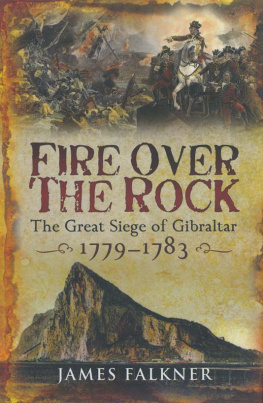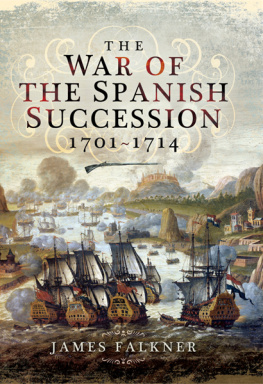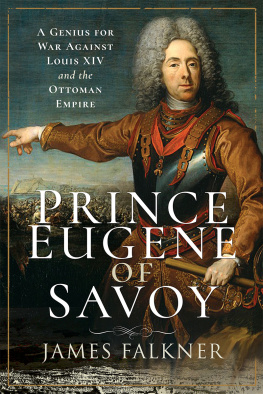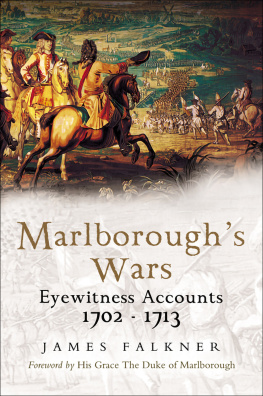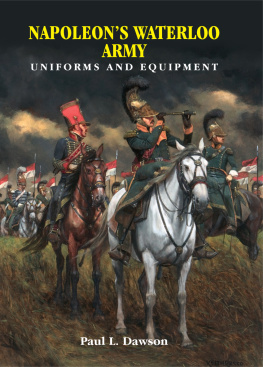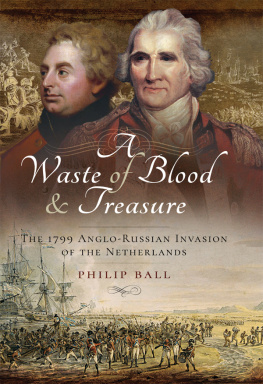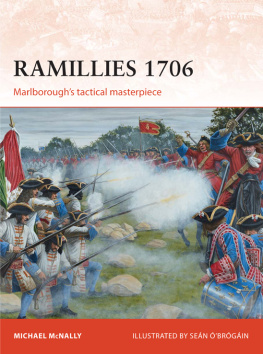BIBLIOGRAPHY
It seems strange that no single individual written work has been devoted to such a significant event as the Battle of Ramillies. Few battles were as sudden and exciting, or victory more complete and astonishing, while such profound and lasting effects on European history would seem to have merited at least one book before now. Perhaps the events on the Sunday in May were so stark, so stunning in their impact, the success so incontrovertible, that there was not much more to say, beyond stating the bald facts. Well, that is not the case there is plenty to ponder over when considering the catastrophe that overtook Marshal Villerois fine army, and eminent authors such as Frank Taylor, Winston Churchill and David Chandler have in their own ways devoted extensive chapters to the battle in their published works, which are listed below.
All battles have within their complex details some small mysteries, and Ramillies is no exception, even leaving aside the rather large mystery of why it took Villeroi so long to realize what Marlborough was up to (the lie of the ground doesnt entirely explain it). There is considerable, well-documented, comment on the timely arrival of the Danish cavalry who took such a prominent part in the destruction of the French right Wing. However, rather less is known, or commented on, about the Danish infantry who also took part in the fighting that day. That they did so is not in doubt, for they provided the depth battalions during Orkneys attack on Offuz and Autre-Eglise, but their presence with the Dukes army, when their mounted compatriots were, until a very late stage, absent and waiting for their arrears of pay, is a puzzle. The foot soldiers could hardly have kept pace with their mounted comrades on the march to join the Dukes army. However, John Millner in his Compendious Journal (pp. 171 and 177), who took part in the fighting that day on the right flank, refers to the Danes Foot and says that they joind and fell in with six battalions and three squadrons of Danes more than the first number before given [Wrttembergs twenty-one squadrons of cavalry]. Major Peter Verneys voluminous notes on the orders of battle of the armies also refer to the Danish infantry being in action, as does David Chandler in one of his footnotes to the John Deane memoirs (p. 33), so it seems that there was a second, later, reinforcement by the Danes, not usually mentioned in accounts of the campaign.
Prominent amongst the handful of available eye-witness accounts of the Ramillies battle is that left by Colonel Jean-Martin De La Colonie, whose erudite and informative memoirs were translated into English by W C Horsley and published in 1904 as the Chronicles of an Old Campaigner. Although this valiant French soldier was mostly engaged in the heavy fighting at the southern end of the Ramillies battlefield (without a great deal of success), his reminiscences of the events that rapidly overtook, and overwhelmed, the French and Bavarian armies that Sunday are vivid, interesting and valuable.
Alison, A, Life of John, Duke of Marlborough , 1852
Atkinson, C T, Marlborough and the Rise of the British Army , 1921
, Ramillies Battlefield , Journal of the Society for Army Historical Research ( JSAHR ), 1960
Barnett, C, Marlborough , 1974
Belloc, H, The Strategy and Tactics of the Great Duke of
Marlborough , 1933
Bishop, M, Life and Adventures, 1701 1711 , 1744
Burn, W, A Scots Fusilier and Dragoon Under Marlborough , JSAHR , 1936
Burrell, S (ed), Amiable Renegade: Memoirs of Captain Peter Drake , 1960
Burton, I, The Captain General , 1968
Chandler, D, The Art of Warfare in the Age of Marlborough , 1983
, Marlborough as Military Commander , 1984
(ed), Journal of John Deane , JSAHR , 1984
(ed), Captain Robert Parker and the Comte de Merode-Westerloo , 1968
Churchill, W S, Marlborough: His Life and Times , 1947
Coxe, W, Memoirs of John, 1st Duke of Marlborough , 1848
Crockatt, J, Marlborough , 1971
Dickson, P, Red John of the Battles , 1973
Drake, P, Memoirs , 1755
Falkner, J, Great and Glorious Days , 2002
, Blenheim, 1704 , 2004
, Marlboroughs Wars: Eye Witness Accounts , 2005
Fortescue, J, History of the British Army , 1901
(ed) , Life and Adventures of Mrs Christian Davies , 1929
Horsley, W (ed), Chronicles of an Old Campaigner , 1904
Kane, R, Campaigns of King William and Queen Anne , 1745
Lediard, T, Life of John, Duke of Marlborough , 1736
Liddell Hart Centre, Papers of Major Peter Verney (relating to Orders of Battle at Ramillies)
Millner, J, A Compendious Journal , 1733
Murray, G (ed), Letters and Dispatches of the Duke of Marlborough , 1845
Orkney (Hamilton), G, Letters of 1st Earl Orkney , English Historical Review , 1904
Parker, R, Memoirs , 1747
St John, B (ed), Memoirs of the Duc de St Simon , 1878
Taylor, F, The Wars of Marlborough , 1921
Tindal, N, Continuation of Rapins History of England , 1738
Trevelyan, G, Ramillies and the Union with Scotland , 1932
Wykes, A, The Royal Hampshire Regiment , 1968
Chapter 1
IF WE LIE STILL, THIS IS ALL FOR NOTHING
T HE SICKLY KING CARLOS II of Spain (rather unsympathetically nicknamed the Sufferer) died on 1 November 1700, without children. No one wanted trouble over the issue, certainly not war, and plans had been made that a Bavarian prince, Joseph Ferdinand (son of the Elector, Maximilien-Emmanuel Wittelsbach), should have the throne when it became vacant, but that young man had died unexpectedly the previous year. As a result, the Second Partition Treaty, agreed in June 1699, set out that Archduke Charles of Austria should accede to the throne at the appropriate time, while French interests were to be catered for with territorial concessions elsewhere. The Austrian Emperor, Leopold I, had set aside his own claim in his youngest sons favour. Despite this practical solution to a tricky problem, French influence at the Court in Madrid led directly to the vacant throne being offered in the deceased King Carloss will to the young Philippe, Duc dAnjou, grandson of Louis XIV of France. Though aware that trouble might result, the Sun King reluctantly gave his consent to acceptance of the tempting offer. Gentlemen, said he to his assembled courtiers, this is the King of Spain. There was understandable and inevitable concern throughout Europe at the potential increase in Louis XIVs reach and power, once a French prince of the blood was on the throne in Madrid, liable to answer to his grandfathers bidding.
By the close of the seventeenth century, Spain was, it is true, financially lame and militarily almost impotent, but her vast empire stretched across not only most of the Iberian peninsula but also wide areas of Italy, the Mediterranean, the Philippines and the Americas. In addition, the rich Spanish (or Southern) Netherlands shared a long border with Holland, and this important region had, more than once, been the avenue by which Louis XIV, when in belligerent frame of mind, marched his armies to attack the Dutch. This concern over the future of the Spanish empire, and the extension of French influence, was made worse by a series of diplomatic miscalculations by Louis XIV (including the dreadful gaffe of recognizing the son of the exiled King James II as the rightful heir to the throne of England). The resulting outrage in London was severe and heartfelt, but this might have been smoothed over in time. Camille dHostun, the French ambassador to London, in particular, was very active. Of greater strategic concern was the French occupation of the Spanish Netherlands, where cherished Barrier Towns, guaranteed by treaty in the late 1690s and garrisoned by Dutch troops, were seized in February 1701. Louis XIV claimed to be protecting his grandsons possession, but actually he was spurred on to do so by Marshal Vauban, his engineer genius, who felt that the defence of Frances northern border had insufficient depth to be really effective. This move forward offered the chance to improve things under a flimsy cloak of legality.


